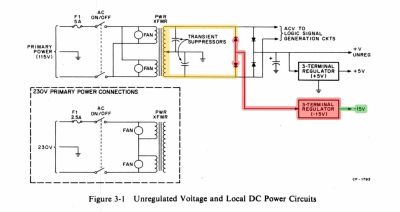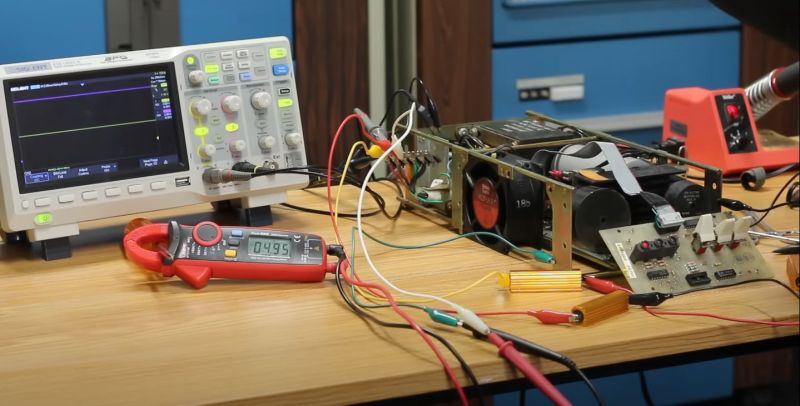After we last saw [David Lovett] of [Usagi Electric], he was knee-deep in trying to fix a DEC PDP-11/03 power supply, which fortunately led to a fixed PSU and a very happy PDP-11/23 system installed in the enclosure, as he covers in today’s video. Previously, we had covered his debugging attempt of this very much dead power supply, which had led [David] down many fruitless rabbitholes. By the time he was taking various components off the board to try and induce certain results, he threw in the towel and went back to the drawing board, assisted with many community comments.

Much of the confusion came down to not really understanding how this PDP-11/03 PSU design works, which isn’t that crazy in hindsight, considering how quaint it is. Although [David] originally focused on the +5V rail, a small detail that was in the schematics is that the 5V rail is based around a 7805 that has its ground referenced to the -15V rail.
It is this 7805 that provides a linearly regulated 5V rail up till its current limit, at which point the control transistor gets biased sufficiently to start conducting, which eventually triggers the driver transistor that is responsible for driving the pass switch transistor. This then charges L2 from the unregulated supply, which is used effectively as a switching mode power supply until the current across the 7805 drops sufficiently that it becomes the primary 5V rail source again. This repeats at a kHz rate, making it more or less an SMPS as we know it today, but heavily reliant on the -15V rail as can be observed in the schematic.

When [David] measured the -15V rail, it was thus little surprise that this rail was not working, which explained why the 5V rail never managed to get going. Fortunately, diagnosing the -15V rail was far more straightforward, as it just uses a 7915 along with some diodes on the unregulated supply from the transformer. Here it turned out that at least one of the diodes had stopped being a diode and was just passing current in both directions. As [David] accidentally crushed two more diodes in the process of removing the broken one, he installed three new ones, along with some fresh components on the 5V rail to replace those which he had previously removed. This thus left flicking the switch and hoping that everything was fixed now.
Since nothing ever works the first try, [David] then remembered he had to replace the resistor which he had accidentally turned into an incandescent lightbulb in the previous video, but one resistor later, the PSU purred to life. After installing PDP-11/23 processor and memory cards into the case, the system seemed quite happy with this newly restored PSU and giving [David] hopefully the easily portable PDP-11 system he can take to conventions.

















This regulator topology was not uncommon back in the 70’s & 80’s
The moral of the story: progress is much easier when good documentation exists.
Crimping those ribbon cable connectors requires parallel pressure that most pliers can’t deliver.
I use a simple mod to my bench drill press. A home made T piece is mounted in the chuck, and works a charm. ( I have crimped over 100 units this way.) The T piece consists of a short length of 12mm square stock (scavenged from an old burglar bar) welded onto a m8 bolt.
I use a vise
This has always been the problem with old computer power supplies – they are essentially closed-loop control systems, and breaking the loop at any point can make matters worse unless you understand the whole system. I remember going around in circles trying to get power supplies in Tektronix equipment running, because they often used multiple-output supplies that depended on a bootstrap process to get them started. What helps here is that crowbar circuits were ubiquitous in that era, which means it was unlikely a failed power supply was going to smoke the entire computer.
Years ago, I got a dead PDP-8 (a model “S” — stands for “slow”) for a song. Diagnosis revealed a dead DEC power supply, and further poking showed that ALL FOUR of the diodes in the main bridge were open, but there were no visible clues. My best guess is that it started out with all four, and as they died one by one, the thing just kept on providing power with no other indication. Finally, the last one expired and the thing went dead.